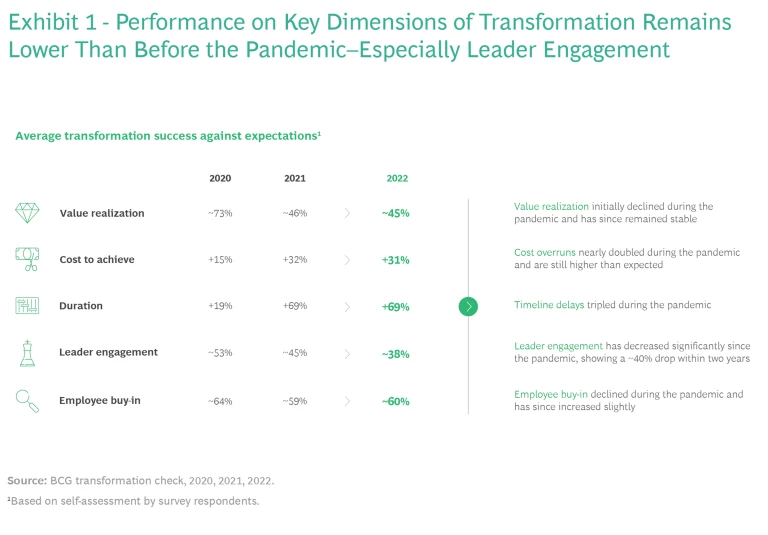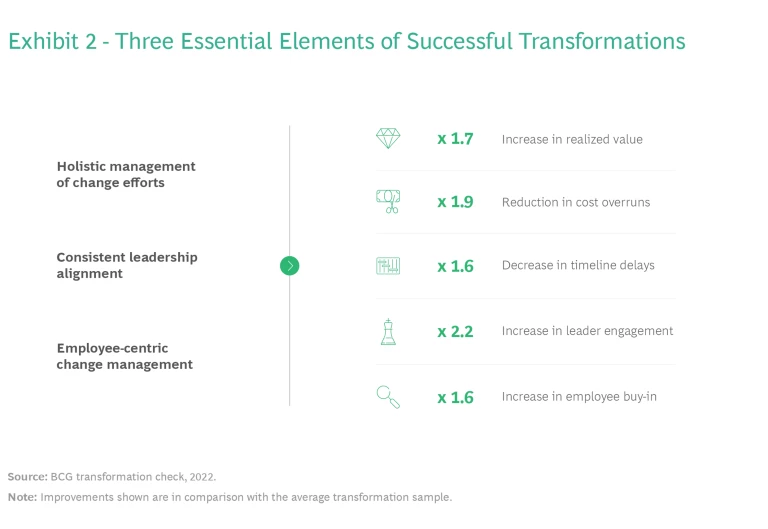The business environment just keeps getting tougher, but transformation is still an imperative. A new survey confirms that five measures can make a big difference in results.
Amid ongoing strains associated with the pandemic, along with geopolitical tensions, the shift to hybrid work , supply chain disruptions, and other challenges, most companies remain remarkably resilient in terms of their ability to transform. However, leader engagement in transformation is declining, continuing a downward trend over the past several years. The good news is that it’s still possible to successfully manage transformations in the current environment, provided leaders reengage and focus on the right things.
Those are the central findings of BCG’s latest survey on the state of corporate transformations. The survey—which drew responses from approximately 1,000 companies around the world—aims to provide business leaders with a data-driven overview of the current transformation landscape so they can better understand how to design and implement a successful change program. It follows similar analyses conducted in 2019 , 2020 , and 2021 and is the latest addition to our rich database of detailed transformation data on more than 4,000 transformation efforts.
The Impact of Three Megatrends on Transformation
This year’s survey focused on how three megatrends—the adoption of artificial intelligence, climate and sustainability goals, and hybrid work—are compounding the difficulties of transformation. We asked respondents about the importance of these trends, their companies’ relevant internal capabilities, and how prepared they are to deal with the opportunities and challenges the trends present.
Notably, transformation leaders were far more likely than transformation laggards to consider AI, climate and sustainability, and hybrid work important—and were more likely to say they are prepared to respond to those trends. The clear implication is that companies with strong transformation capabilities are aware of their operating environment, understand the potential of broad trends to create both disruptions and opportunities, and are able to pivot as needed. These companies are more future oriented and resilient; they understand that they need to sow today what they want to harvest in the future.
Leader engagement in transformation is declining, continuing a downward trend over the past several years.
Similarly, transformation leaders understand the need to continually invest to develop capabilities. Although these organizations are more likely than transformation laggards to feel well-prepared to meet emerging trends, only about half (52%) rated their ability to respond to megatrends as high, compared with 29% for transformation laggards.
If a company does not invest in its future readiness and is thus not ready to act accordingly, it can quickly be pushed to the brink. Conversely, having the right capabilities equips companies to succeed amid changing circumstances.
Continued Fallout from the Pandemic
Our methodology looked at the five quantifiable dimensions of success in a transformation: value realization, cost to achieve, duration, leader engagement, and employee buy-in. Overall, the results show that across all five dimensions, performance is worse than it was before the pandemic—a trend that initially showed up in last year’s results and continues in the current findings. (See Exhibit 1.)

The value realized from a transformation has declined significantly—from 73% in 2020 to 45% in 2022. Similarly, employee buy-in remains low, and both cost overruns and program timelines have tripled, though all of these numbers have essentially stabilized in the past two years.
The biggest finding in the most recent results is a continued decline in leader engagement. Although the overall drop is lower than that of some other metrics, from 53% in 2020 to 38% in 2022, the fact that the decline is continuing is worrisome. Moreover, the disconnect between leadership engagement and employee buy-in is surprising. At most successful organizations, leaders drive large-scale change efforts, serve as role models, and support employees in embedding the changes brought about by the transformation. When leaders don’t meet this mandate, employees care less and transformations don’t succeed. (See the sidebar, “Voices from the Frontlines of Transformation.”)
Voices from the Frontlines of Transformation
Voices from the Frontlines of Transformation
“The magnitude of our recent transformation affected our employees personally and emotionally. We had a new CEO and a new business model that changed the way we served our customers, plus most of our employees were working from home. We had to take a step back and narrow our focus. The hardest part was stopping projects that people had already fallen in love with.”
“Midlevel managers had to navigate between the ‘everything remains the same’ attitude of the workers they oversaw and the pressure to change from above. Leaders at this level often didn’t feel well supported or involved and thought that their top management was not prioritizing among different initiatives. In response, we introduced weekly meetings among top management to align on a smaller number of priorities.”
“At some stage, we realized that our leaders had lost the ability to guide their teams—because they had no significant compass on where to focus their efforts and were working with overly detailed plans. We had to reorient everyone to make sure we were maintaining overall momentum, which sometimes meant empowering leaders and teams to figure solutions out as they work on a problem. This was tough, because we as a company like to engineer a solution before we do anything.”
“The ability of our leaders to lead in such uncertain times was not as we expected. I have to admit that this was a flaw in my thinking: I had not spent enough time to understand how ready our people were and tried to push knowledge instead of building up their capabilities.”
“Some leaders didn’t know how to explain where the company is heading. They hunkered down and devoted their energy to the most immediate priorities. We significantly changed our communication. In the past it was about facts, outcomes, and orientation. Now it is a lot more about process, feelings, and our own struggles. Admitting that we don’t have the answers but have a plan how to get to them helped us to break out of this negative spiral.”
At the same time, the data shows that despite a continued decline in leader engagement in transformations, employee buy-in has remained stable. One possible explanation is that leaders continue to face new challenges in the post-pandemic environment, whereas employees are becoming more accustomed to new ways of working and have become more resilient.
Regardless of the underlying cause, companies should redouble their efforts to engage leaders at all levels in their transformation efforts by reducing complexity and making the overall goals and pathway clear. As in previous years, our findings identified three distinct elements that make the real difference between transformation champions and laggards: holistic management of all change efforts, coherent leadership, and employee-centric change management. (See Exhibit 2.) Notably, these three areas comprise a framework for transformation , which BCG research has shown leads to greater financial performance.

Critical Insights for Change Leaders
We have distilled the insights of our survey into five winning strategies that can provide chief transformation officers with practical steps for success.
Lead with clarity and transparency. In an era of constant change, leaders sometimes struggle to reduce uncertainty and provide clear guidance to their teams. Some fall silent when they aren’t sure about a future path. Others overcompensate by providing false assurances or drawing up overly detailed plans. Instead, leaders must remain authentic and open, acknowledging change and uncertainty without being paralyzed by it. BCG research has found that some of the qualities of generative leadership that made companies more flexible and creative during the pandemic can help them take on bigger challenges—like sustainability transformations—now.
Implement changes step by step. To ensure long-term commitment throughout the process, organizations should break down large-scale transformations into smaller changes that are realistic and achievable. Success requires prioritizing the most important initiatives—those that will address the most urgent needs or generate the fastest improvements—and suspending those that are unimportant. Some organizations may need to adapt their culture to ensure that teams running deprioritized initiatives don’t perceive this as a career-ending disaster but rather as an inherent part of a culture of agility and value focus.
Subscribe to our Business Resilience E-Alert
Make sure the leadership team is on the same page. With uncertainty growing in all aspects of business, it’s important for the executive team to invest heavily in making sure that leaders are in clear agreement on the goals and approach of the transformation. Some senior teams believe—mistakenly—that they don’t need to reinforce messages and goals over time, because those decisions have already been communicated and aren’t worth revisiting. In fact, the opposite is true. In a fast-changing business environment, consistently reinforcing a clear message—and refining it based on ongoing feedback from leaders throughout the organization—is the only way to ensure clarity and focus on the right priorities.
Empower the frontline. Transformations succeed or fail at the frontlines. Engaging frontline leaders, empowering them to make decisions, enabling them to provide guidance to employees amid uncertainty, and listening to and heeding their feedback on what is working and what is not are key to getting the organization focused on what needs to be done.
Manage the change load. Employees should not be confronted with too many changes at once, or they will make their own decisions about what is important and what not—potentially in ways that don’t support the company’s interests. It’s crucial to manage the change load on the organization and identify emerging issues early on.
The bright side of the all the change in the business environment is that it creates new opportunities for companies to differentiate themselves and outpace the competition. To do so, leaders must remain engaged in the process and focused on the right change priorities. By following the measures discussed here, companies can improve their odds in transformation, capitalize on a changing landscape, and position themselves for long-term success.
Thanks to Michaela Schöll and Kim Mertens for their significant contributions to this publication.













